AnyProxy
本文档的适用范围是AnyProxy 4.0,欢迎提供反馈
Ref: English Doc
AnyProxy是一个开放式的HTTP代理服务器。
Github主页:https://github.com/alibaba/anyproxy
主要特性包括:
- 基于Node.js,开放二次开发能力,允许自定义请求处理逻辑
- 支持Https的解析
- 提供GUI界面,用以观察请求
相比3.x版本,AnyProxy 4.0的主要变化:
- 规则文件(Rule)全面支持Promise和Generator
- 简化了规则文件内的接口
- Web版界面重构

快速开始
作为全局模块
安装
对于Debian或者Ubuntu系统,在安装AnyProxy之前,可能还需要安装 nodejs-legacy
sudo apt-get install nodejs-legacy
然后,安装AnyProxy
npm install -g anyproxy
启动
- 命令行启动AnyProxy,默认端口号8001
anyproxy
- 启动后将终端http代理服务器配置为127.0.0.1:8001即可
- 访问http://127.0.0.1:8002 ,web界面上能看到所有的请求信息
其他命令
- 配置启动端口,如1080端口启动
anyproxy --port 1080
作为npm模块使用
AnyProxy可以作为一个npm模块使用,整合进其他工具。
如要启用https解析,请在代理服务器启动前自行调用
AnyProxy.utils.certMgr相关方法生成证书,并引导用户信任安装。或引导用户使用anyproxy-ca方法。
- 引入
npm i anyproxy --save
- 使用举例
const AnyProxy = require('anyproxy');
const options = {
port: 8001,
rule: require('myRuleModule'),
webInterface: {
enable: true,
webPort: 8002
},
throttle: 10000,
forceProxyHttps: false,
wsIntercept: false, // 不开启websocket代理
silent: false
};
const proxyServer = new AnyProxy.ProxyServer(options);
proxyServer.on('ready', () => { /* */ });
proxyServer.on('error', (e) => { /* */ });
proxyServer.start();
//when finished
proxyServer.close();
Class: AnyProxy.proxyServer
创建代理服务器
const proxy = new AnyProxy.proxyServer(options)optionsport{number} 必选,代理服务器端口rule{object} 自定义规则模块throttle{number} 限速值,单位kb/s,默认不限速forceProxyHttps{boolean} 是否强制拦截所有的https,忽略规则模块的返回,默认falsesilent{boolean} 是否屏蔽所有console输出,默认falsedangerouslyIgnoreUnauthorized{boolean} 是否忽略请求中的证书错误,默认falsewsIntercept{boolean} 是否开启websocket代理,默认falsewebInterface{object} web版界面配置enable{boolean} 是否启用web版界面,默认falsewebPort{number} web版界面端口号,默认8002
Event:
ready- 代理服务器启动完成
- 示例
proxy.on('ready', function() { })Event:
error- 代理服务器发生错误
- 示例
proxy.on('error', function() { })Method:
start- 启动代理服务器
- 示例
proxy.start();Method:
close- 关闭代理服务器
- 示例
proxy.close();
AnyProxy.utils.systemProxyMgr
- 管理系统的全局代理配置,方法调用时可能会弹出密码框
- 使用示例
// 配置127.0.0.1:8001为全局http代理服务器 AnyProxy.utils.systemProxyMgr.enableGlobalProxy('127.0.0.1', '8001'); // 关闭全局代理服务器 AnyProxy.utils.systemProxyMgr.disableGlobalProxy();AnyProxy.utils.certMgr
- 管理AnyProxy的证书
AnyProxy.utils.certMgr.ifRootCAFileExists()- 校验系统内是否存在AnyProxy的根证书
AnyProxy.utils.certMgr.generateRootCA(callback)- 生成AnyProxy的rootCA,完成后请引导用户信任.crt文件
- 样例
const AnyProxy = require('anyproxy'); const exec = require('child_process').exec; if (!AnyProxy.utils.certMgr.ifRootCAFileExists()) { AnyProxy.utils.certMgr.generateRootCA((error, keyPath) => { // let users to trust this CA before using proxy if (!error) { const certDir = require('path').dirname(keyPath); console.log('The cert is generated at', certDir); const isWin = /^win/.test(process.platform); if (isWin) { exec('start .', { cwd: certDir }); } else { exec('open .', { cwd: certDir }); } } else { console.error('error when generating rootCA', error); } }); }
代理HTTPS
- AnyProxy默认不对https请求做处理,如需看到明文信息,需要配置CA证书
解析https请求的原理是中间人攻击(man-in-the-middle),用户必须信任AnyProxy生成的CA证书,才能进行后续流程
- 生成证书并解析所有https请求
anyproxy-ca #生成rootCA证书,生成后需要手动信任
anyproxy --intercept #启动AnyProxy,并解析所有https请求
代理WebSocket
anyproxy --ws-intercept
当启用
HTTPS代理时,wss也会被代理,但是不会被AnyProxy记录。需要开启--ws-intercept后才会从界面上看到相应内容。
rule模块
AnyProxy提供了二次开发的能力,你可以用js编写自己的规则模块(rule),来自定义网络请求的处理逻辑。
注意:引用规则前,请务必确保文件来源可靠,以免发生安全问题
规则模块的能力范围包括:
- 拦截并修改正在发送的请求
- 可修改内容包括请求头(request header),请求体(request body),甚至是请求的目标地址等
- 拦截并修改服务端响应
- 可修改的内容包括http状态码(status code)、响应头(response header)、响应内容等
- 拦截https请求,对内容做修改
- 本质是中间人攻击(man-in-the-middle attack),需要客户端提前信任AnyProxy生成的CA
开发示例
举例
- 需要编写一个规则模块,在 GET http://httpbin.org/user-agent 的返回值里加上测试信息,并延迟5秒返回
Step 1,编写规则
// file: sample.js module.exports = { summary: 'a rule to hack response', *beforeSendResponse(requestDetail, responseDetail) { if (requestDetail.url === 'http://httpbin.org/user-agent') { const newResponse = responseDetail.response; newResponse.body += '- AnyProxy Hacked!'; return new Promise((resolve, reject) => { setTimeout(() => { // delay resolve({ response: newResponse }); }, 5000); }); } }, };Step 2, 启动AnyProxy,加载规则
- 运行
anyproxy --rule sample.js
- 运行
Step 3, 测试规则
用curl测试
curl http://httpbin.org/user-agent --proxy http://127.0.0.1:8001用浏览器测试:配置浏览器http代理为 127.0.0.1:8001,访问 http://httpbin.org/user-agent
经过代理服务器后,期望的返回如下
{ "user-agent": "curl/7.43.0" } - AnyProxy Hacked!Step 4, 查看请求信息
- 浏览器访问http://127.0.0.1:8002 ,界面上能看到刚才的请求信息
处理流程
- 处理流程图如下
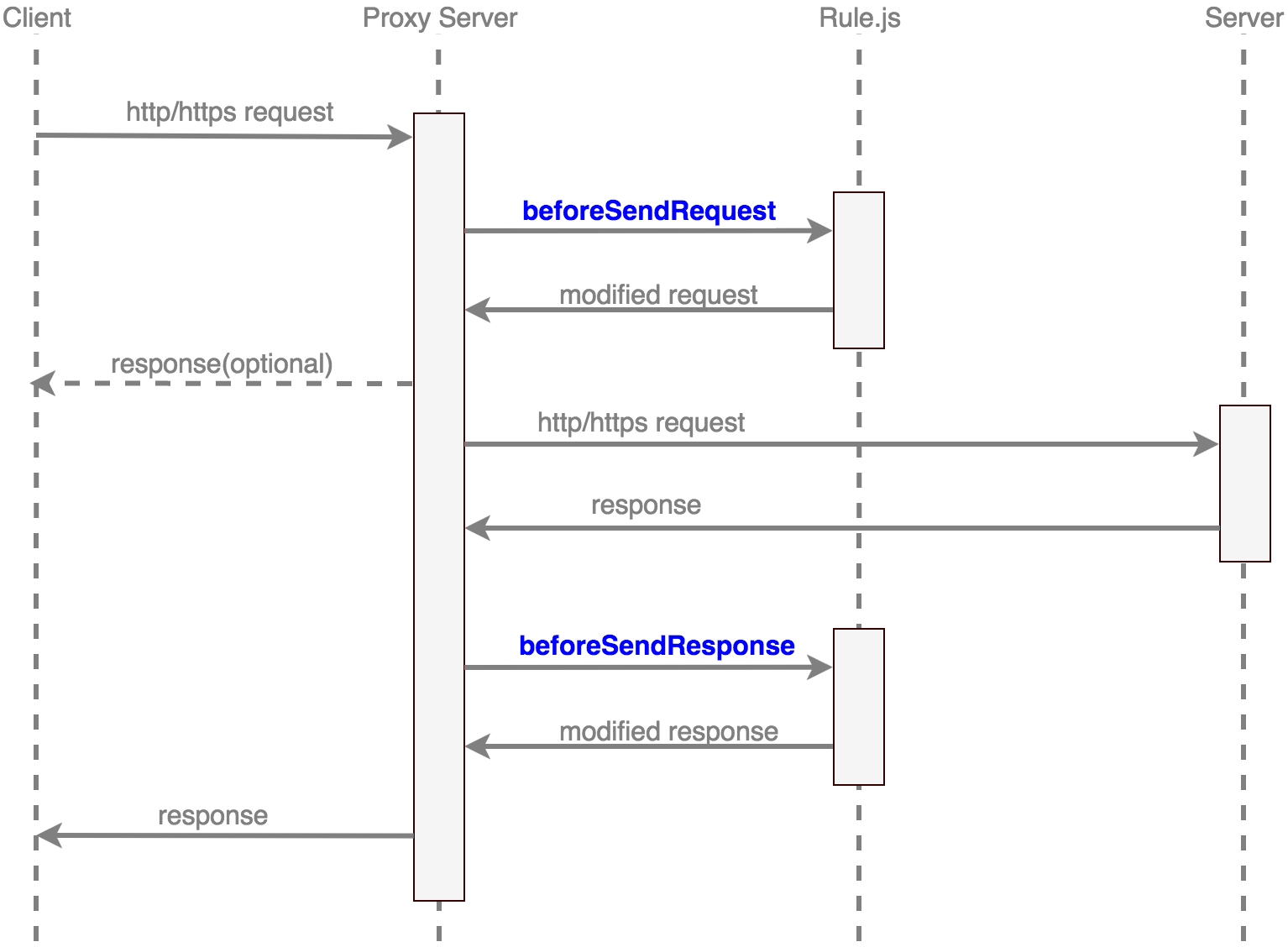
当http请求经过代理服务器时,具体处理过程是:
- 收集请求所有请求参数,包括method, header, body等
- AnyProxy调用规则模块
beforeSendRequest方法,由模块做处理,返回新的请求参数,或返回响应内容 - 如果
beforeSendRequest返回了响应内容,则立即把此响应返回到客户端(而不再发送到真正的服务端),流程结束。 - 根据请求参数,向服务端发出请求,接收服务端响应。
- 调用规则模块
beforeSendResponse方法,由模块对响应内容进行处理 - 把响应信息返回给客户端
当代理服务器收到https请求时,AnyProxy可以替换证书,对请求做明文解析。
- 调用规则模块
beforeDealHttpsRequest方法,如果返回true,会明文解析这个请求,其他请求不处理 - 被明文解析后的https请求,处理流程同http一致。未明文解析请求不会再进入规则模块做处理。
- 调用规则模块
如何引用
如下几种方案都可以用来引用规则模块:
- 使用本地路径
anyproxy --rule ./rule.js 使用在线地址
anyproxy --rule https://sample.com/rule.js使用npm包
- AnyProxy使用
require()加载本地规则,你可以在参数里传入一个本地的npm包路径,或是某个全局安装的npm包
anyproxy --rule ./myRulePkg/ #本地包 npm i -g myRulePkg && anyproxy --rule myRulePkg #全局包- AnyProxy使用
rule接口文档
规则模块应该符合cmd规范,一个典型的规则模块代码结构如下。模块中所有方法都是可选的,只需实现业务感兴趣的部分即可。
module.exports = {
// 模块介绍
summary: 'my customized rule for AnyProxy',
// 发送请求前拦截处理
*beforeSendRequest(requestDetail) { /* ... */ },
// 发送响应前处理
*beforeSendResponse(requestDetail, responseDetail) { /* ... */ },
// 是否处理https请求
*beforeDealHttpsRequest(requestDetail) { /* ... */ },
// 请求出错的事件
*onError(requestDetail, error) { /* ... */ },
// https连接服务器出错
*onConnectError(requestDetail, error) { /* ... */ }
};
规则文件中,除了summary,都是由 co 驱动的,函数需要满足yieldable。可以返回promise或使用generator函数。
summary
summary(): string | summary:string
- 规则模块的介绍文案,用于AnyProxy提示用户, 可以是一个函数,也可以是一个普通的字符串
beforeSendRequest
beforeSendRequest(requestDetail)
- AnyProxy向服务端发送请求前,会调用
beforeSendRequest,并带上参数requestDetail requestDetailprotocol{string} 请求使用的协议,http或者httpsrequestOptions{object} 即将发送的请求配置,供require('http').request作为使用。详见:https://nodejs.org/api/http.html#http_http_request_options_callbackrequestData{object} 请求Bodyurl{string} 请求url_req{object} 请求的原始request
举例:请求 anyproxy.io 时,
requestDetail参数内容大致如下{ protocol: 'http', url: 'http://anyproxy.io/', requestOptions: { hostname: 'anyproxy.io', port: 80, path: '/', method: 'GET', headers: { Host: 'anyproxy.io', 'Proxy-Connection': 'keep-alive', 'User-Agent': '...' } }, requestData: '...', _req: { /* ... */} }以下几种返回都是合法的
- 不做任何处理,返回null
return null;- 修改请求协议,如强制改用https发起请求
return { protocol: 'https' };- 修改请求参数
var newOption = Object.assign({}, requestDetail.requestOptions); newOption.path = '/redirect/to/another/path'; return { requestOptions: newOption };- 修改请求body
return { requestData: 'my new request data' //这里也可以同时加上requestOptions };- 直接返回客户端,不再发起请求,其中
statusCodeheader是必选字段
return { response: { statusCode: 200, header: { 'content-type': 'text/html' }, body: 'this could be a <string> or <buffer>' } };
beforeSendResponse
beforeSendResponse(requestDetail, responseDetail)
- AnyProxy向客户端发送请求前,会调用
beforeSendResponse,并带上参数requestDetailresponseDetail requestDetail同beforeSendRequest中的参数responseDetailresponse{object} 服务端的返回信息,包括statusCodeheaderbody三个字段_res{object} 原始的服务端返回对象
举例,请求 anyproxy.io 时,
responseDetail参数内容大致如下{ response: { statusCode: 200, header: { 'Content-Type': 'image/gif', Connection: 'close', 'Cache-Control': '...' }, body: '...' }, _res: { /* ... */ } }以下几种返回都是合法的
- 不做任何处理,返回null
return null;- 修改返回的状态码
var newResponse = Object.assign({}, responseDetail.response); newResponse.statusCode = 404; return { response: newResponse };- 修改返回的内容
var newResponse = Object.assign({}, responseDetail.response); newResponse.body += '--from anyproxy--'; return { response: newResponse };
beforeDealHttpsRequest
beforeDealHttpsRequest(requestDetail)
- AnyProxy收到https请求时,会调用
beforeDealHttpsRequest,并带上参数requestDetail - 如果配置了全局解析https的参数,则AnyProxy会略过这个调用
- 只有返回
true时,AnyProxy才会尝试替换证书、解析https。否则只做数据流转发,无法看到明文数据。 - 注意:https over http的代理模式中,这里的request是CONNECT请求
requestDetailhost{string} 请求目标的Host,受制于协议,这里无法获取完整url_req{object} 请求的原始request
- 返回值
true或者false,表示是否需要AnyProxy替换证书并解析https
onError
onError(requestDetail, error)
- 在请求处理过程中发生错误时,AnyProxy会调用
onError方法,并提供对应的错误信息 - 多数场景下,错误会在请求目标服务器的时候发生,比如DNS解析失败、请求超时等
requestDetail同beforeSendRequest中的参数以下几种返回都是合法的
- 不做任何处理。此时AnyProxy会返回一个默认的错误页。
return null;- 返回自定义错误页
return { response: { statusCode: 200, header: { 'content-type': 'text/html' }, body: 'this could be a <string> or <buffer>' } };
onConnectError
onConnectError(requestDetail, error)
- AnyProxy在与目标HTTPS服务器建立连接的过程中,如果发生错误,AnyProxy会调用这个方法
requestDetail同beforeDealHttpsRequest中的参数- 此处无法控制向客户端的返回信息,无需返回值。
rule样例
- 这里提供一些样例,来讲解规则模块的常见用法
- 你可以通过
anyproxy --rule http://....js来加载模块并体验 - 用curl发请求测试的方法如下
- 直接请求服务器:
curl http://httpbin.org/ - 通过代理服务器请求:
curl http://httpbin.org/ --proxy http://127.0.0.1:8001
- 直接请求服务器:
使用本地数据
- 拦截发送到 http://httpbin.org 的请求,使用本地数据代替服务端返回
anyproxy --rule rule_sample/sample_use_local_response.js
/*
sample:
intercept all requests toward httpbin.org, use a local response
test:
curl http://httpbin.org/user-agent --proxy http://127.0.0.1:8001
*/
module.exports = {
*beforeSendRequest(requestDetail) {
const localResponse = {
statusCode: 200,
header: { 'Content-Type': 'application/json' },
body: '{"hello": "this is local response"}'
};
if (requestDetail.url.indexOf('http://httpbin.org') === 0) {
return {
response: localResponse
};
}
},
};
修改请求头
- 修改发送到 httpbin.org 的user-agent
anyproxy --rule rule_sample/sample_modify_request_header.js
/*
sample:
modify the user-agent in requests toward httpbin.org
test:
curl http://httpbin.org/user-agent --proxy http://127.0.0.1:8001
*/
module.exports = {
*beforeSendRequest(requestDetail) {
if (requestDetail.url.indexOf('http://httpbin.org') === 0) {
const newRequestOptions = requestDetail.requestOptions;
newRequestOptions.headers['User-Agent'] = 'AnyProxy/0.0.0';
return {
requestOptions: newRequestOptions
};
}
},
};
修改请求数据
- 修改发送到 http://httpbin.org/post 的post数据
anyproxy --rule rule_sample/sample_modify_request_data.js
/*
sample:
modify the post data towards http://httpbin.org/post
test:
curl -H "Content-Type: text/plain" -X POST -d 'original post data' http://httpbin.org/post --proxy http://127.0.0.1:8001
expected response:
{ "data": "i-am-anyproxy-modified-post-data" }
*/
module.exports = {
summary: 'Rule to modify request data',
*beforeSendRequest(requestDetail) {
if (requestDetail.url.indexOf('http://httpbin.org/post') === 0) {
return {
requestData: 'i-am-anyproxy-modified-post-data'
};
}
},
};
修改请求的目标地址
- 把所有发送到 http://httpbin.org/ 的请求全部改到 http://httpbin.org/user-agent
anyproxy --rule rule_sample/sample_modify_request_path.js
/*
sample:
redirect all https://httpbin.org/user-agent requests to http://localhost:8008/index.html
test:
curl https://httpbin.org/user-agent --proxy http://127.0.0.1:8001
expected response:
'hello world' from 127.0.0.1:8001/index.html
*/
module.exports = {
*beforeSendRequest(requestDetail) {
if (requestDetail.url.indexOf('https://httpbin.org/user-agent') === 0) {
const newRequestOptions = requestDetail.requestOptions;
requestDetail.protocol = 'http';
newRequestOptions.hostname = '127.0.0.1'
newRequestOptions.port = '8008';
newRequestOptions.path = '/index.html';
newRequestOptions.method = 'GET';
return requestDetail;
}
},
*beforeDealHttpsRequest(requestDetail) {
return true;
}
};
修改请求协议
- 把用http协议请求的 http://httpbin.org 改成https并发送
anyproxy --rule rule_sample/sample_modify_request_protocol.js
/*
sample:
redirect all http requests of httpbin.org to https
test:
curl 'http://httpbin.org/get?show_env=1' --proxy http://127.0.0.1:8001
expected response:
{ "X-Forwarded-Protocol": "https" }
*/
module.exports = {
*beforeSendRequest(requestDetail) {
if (requestDetail.url.indexOf('http://httpbin.org') === 0) {
const newOption = requestDetail.requestOptions;
newOption.port = 443;
return {
protocol: 'https',
requestOptions: newOption
};
}
}
};
修改返回状态码
- 把 所有http://httpbin.org 的返回状态码都改成404
anyproxy --rule rule_sample/sample_modify_response_statuscode.js
/*
sample:
modify all status code of http://httpbin.org/ to 404
test:
curl -I 'http://httpbin.org/user-agent' --proxy http://127.0.0.1:8001
expected response:
HTTP/1.1 404 Not Found
*/
module.exports = {
*beforeSendResponse(requestDetail, responseDetail) {
if (requestDetail.url.indexOf('http://httpbin.org') === 0) {
const newResponse = responseDetail.response;
newResponse.statusCode = 404;
return {
response: newResponse
};
}
}
};
修改返回头
- 在 http://httpbin.org/user-agent 的返回头里加上 X-Proxy-By:AnyProxy
anyproxy --rule rule_sample/sample_modify_response_header.js
/*
sample:
modify response header of http://httpbin.org/user-agent
test:
curl -I 'http://httpbin.org/user-agent' --proxy http://127.0.0.1:8001
expected response:
X-Proxy-By: AnyProxy
*/
module.exports = {
*beforeSendResponse(requestDetail, responseDetail) {
if (requestDetail.url.indexOf('http://httpbin.org/user-agent') === 0) {
const newResponse = responseDetail.response;
newResponse.header['X-Proxy-By'] = 'AnyProxy';
return {
response: newResponse
};
}
}
};
修改返回内容并延迟
- 在 http://httpbin.org/user-agent 的返回最后追加AnyProxy的签名,并延迟5秒
anyproxy --rule rule_sample/sample_modify_response_data.js
/*
sample:
modify response data of http://httpbin.org/user-agent
test:
curl 'http://httpbin.org/user-agent' --proxy http://127.0.0.1:8001
expected response:
{ "user-agent": "curl/7.43.0" } -- AnyProxy Hacked! --
*/
module.exports = {
*beforeSendResponse(requestDetail, responseDetail) {
if (requestDetail.url === 'http://httpbin.org/user-agent') {
const newResponse = responseDetail.response;
newResponse.body += '-- AnyProxy Hacked! --';
return new Promise((resolve, reject) => {
setTimeout(() => { // delay the response for 5s
resolve({ response: newResponse });
}, 5000);
});
}
},
};
证书配置
OSX系统信任CA证书
- 类似这种报错都是因为系统没有信任AnyProxy生成的CA所造成的
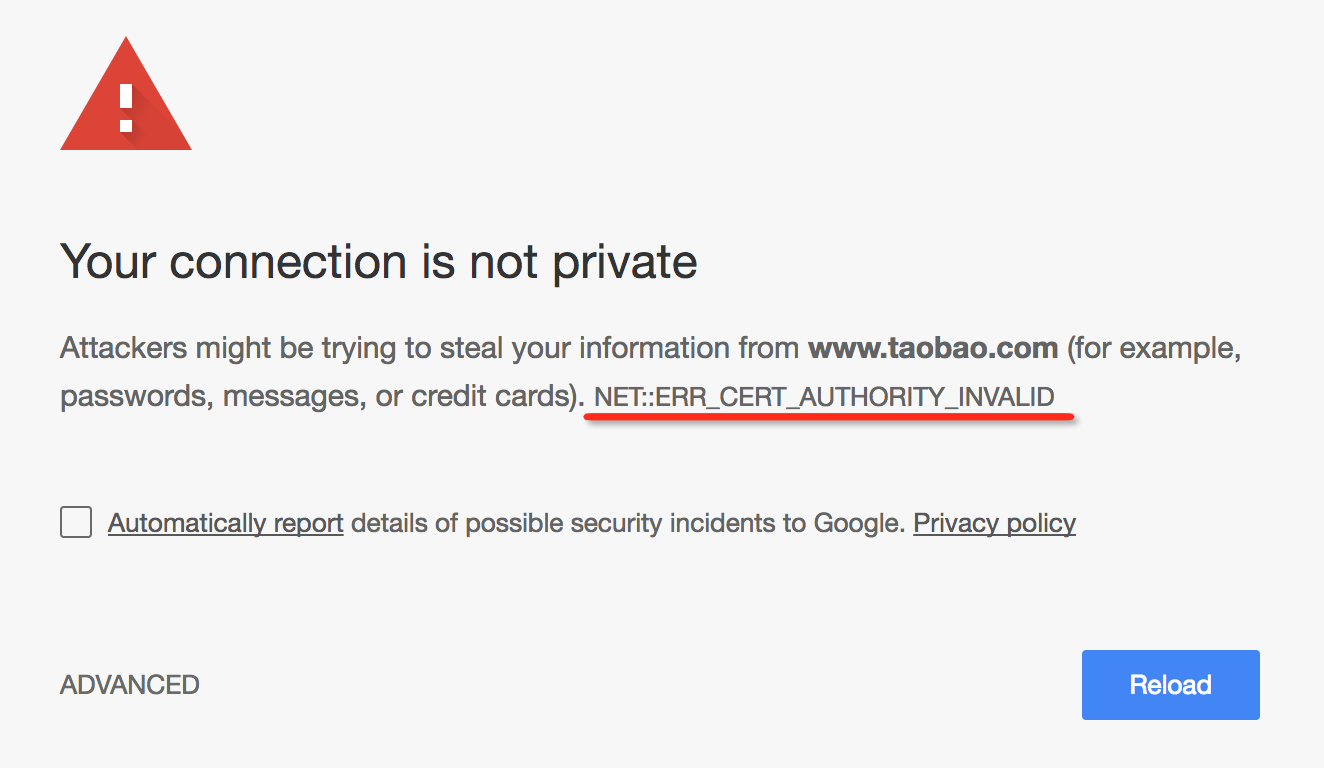
警告:CA证书和系统安全息息相关,建议亲自生成,并妥善保管
安装CA:
双击打开rootCA.crt
确认将证书添加到login或system
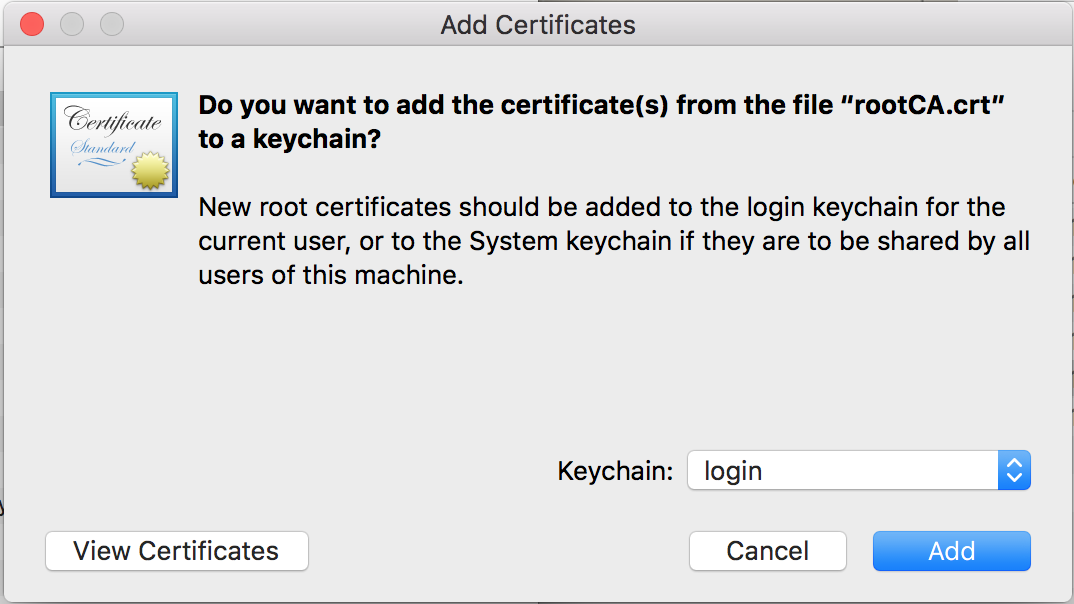
- 找到刚刚导入的AnyProxy证书,配置为信任(Always Trust)
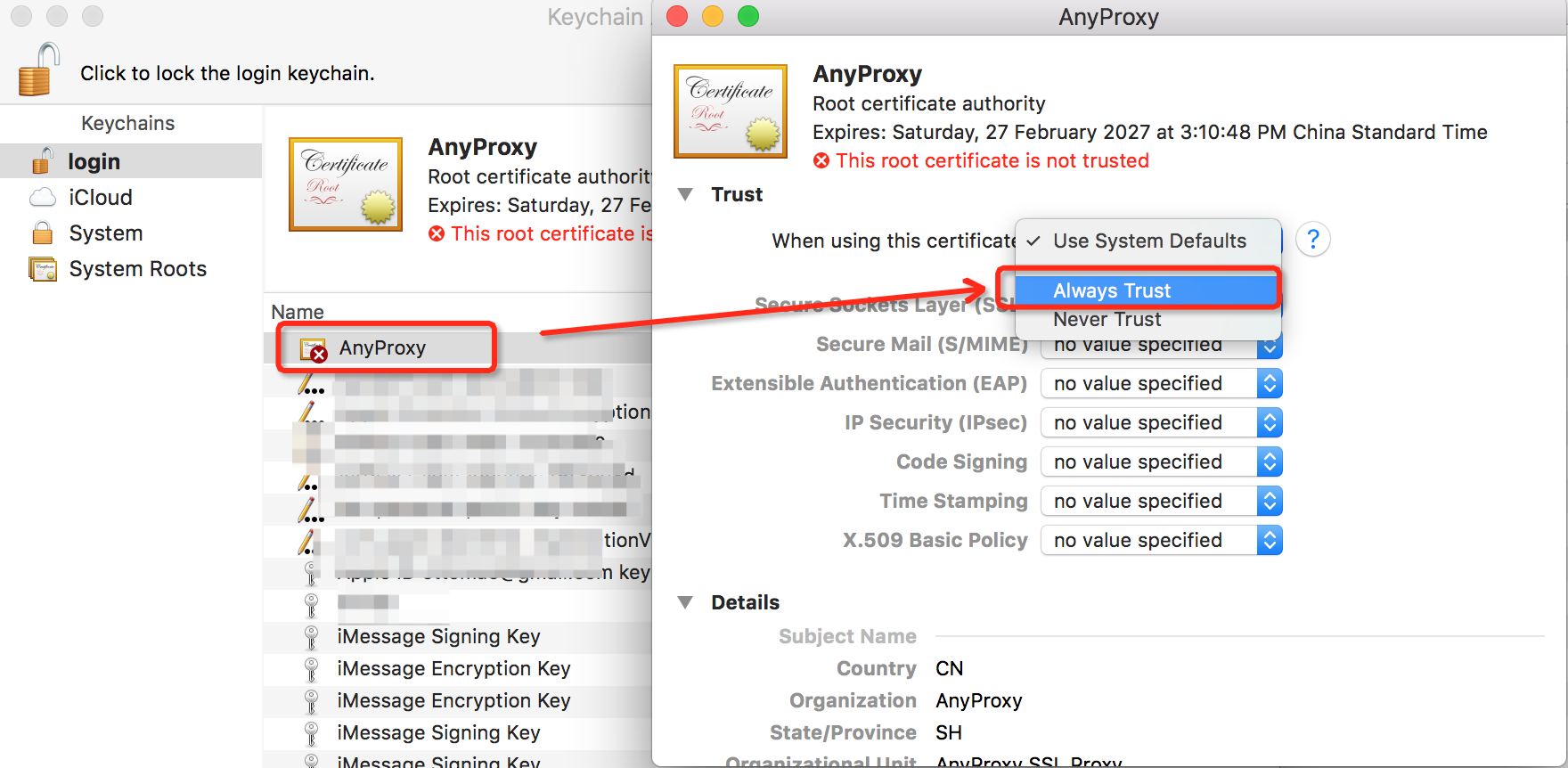
Windows系统信任CA证书

配置OSX系统代理
- 在wifi高级设置中,配置http代理即可
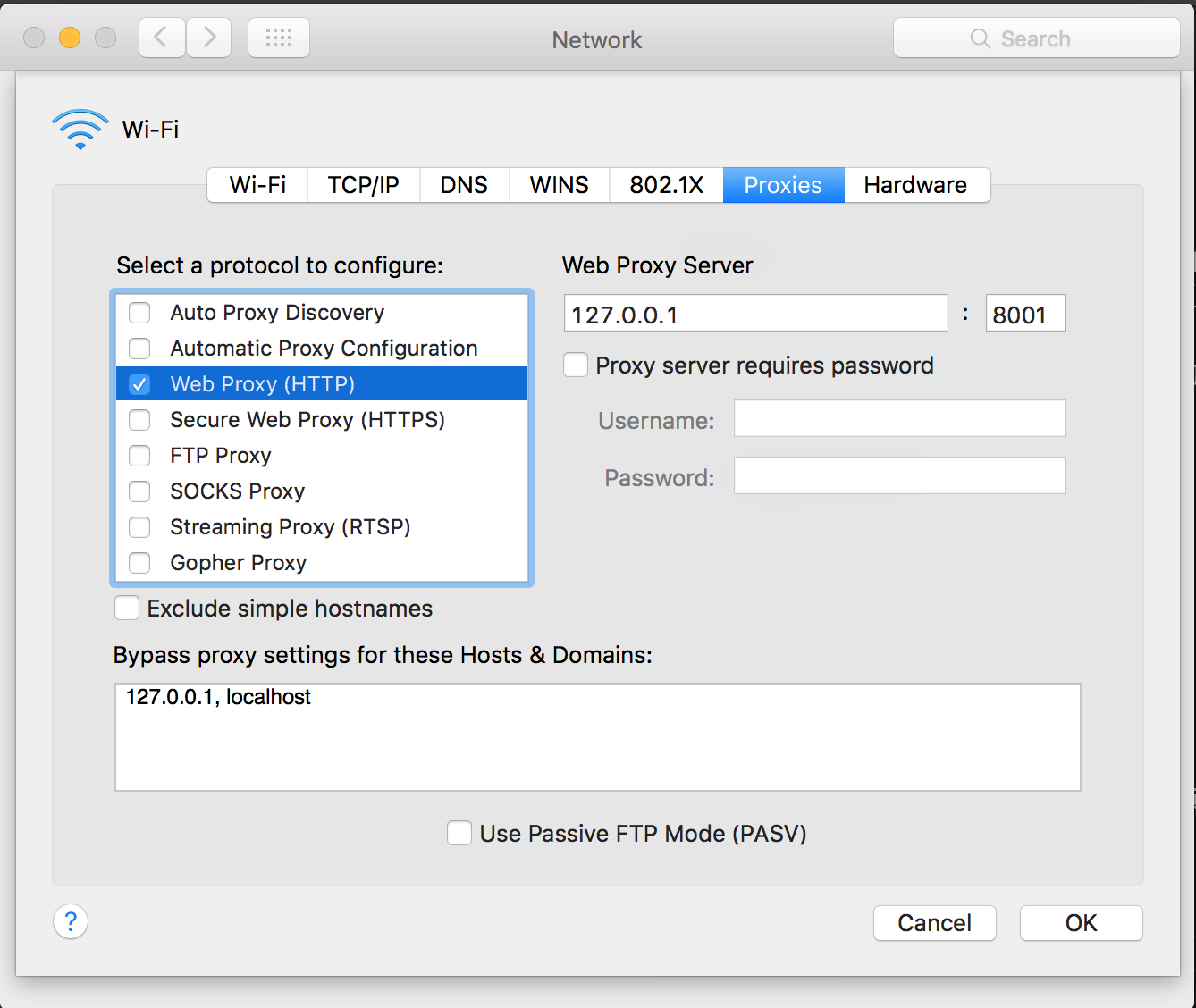
配置浏览器HTTP代理
- 以Chrome的SwitchyOmega插件为例
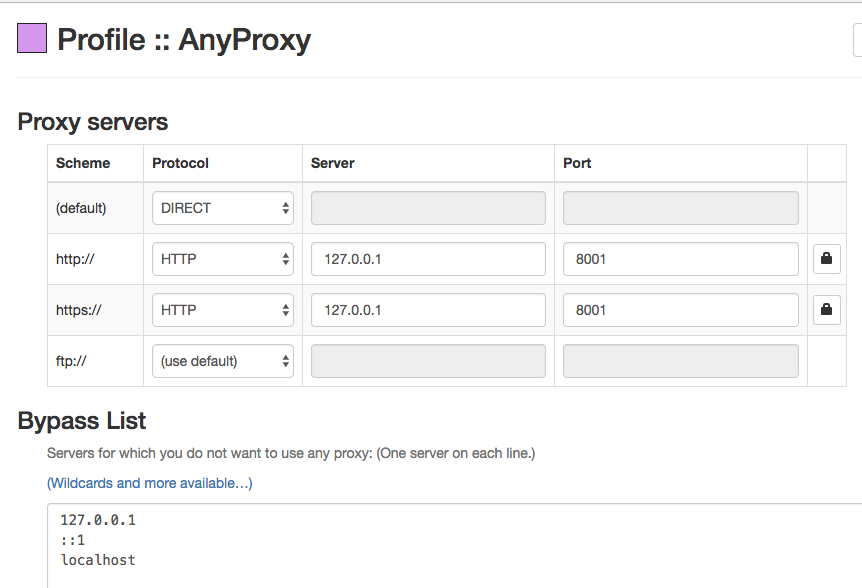
iOS系统信任CA证书
- 点击web ui中的 Root CA,按提示扫描二维码即可安装
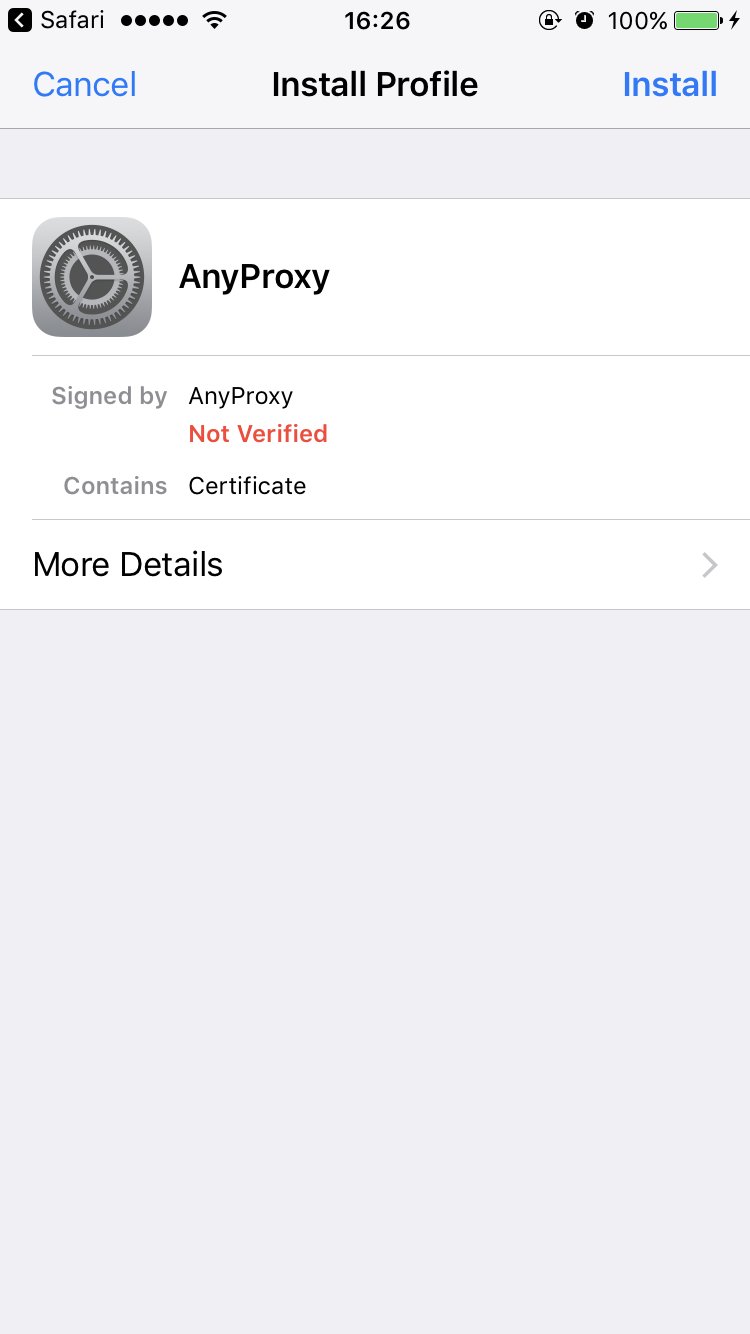
iOS >= 10.3信任CA证书
- 除了上述证书安装过程,还需要在 设置->通用->关于本机->证书信任设置 中把AnyProxy证书的开关打开,否则safari将报错。
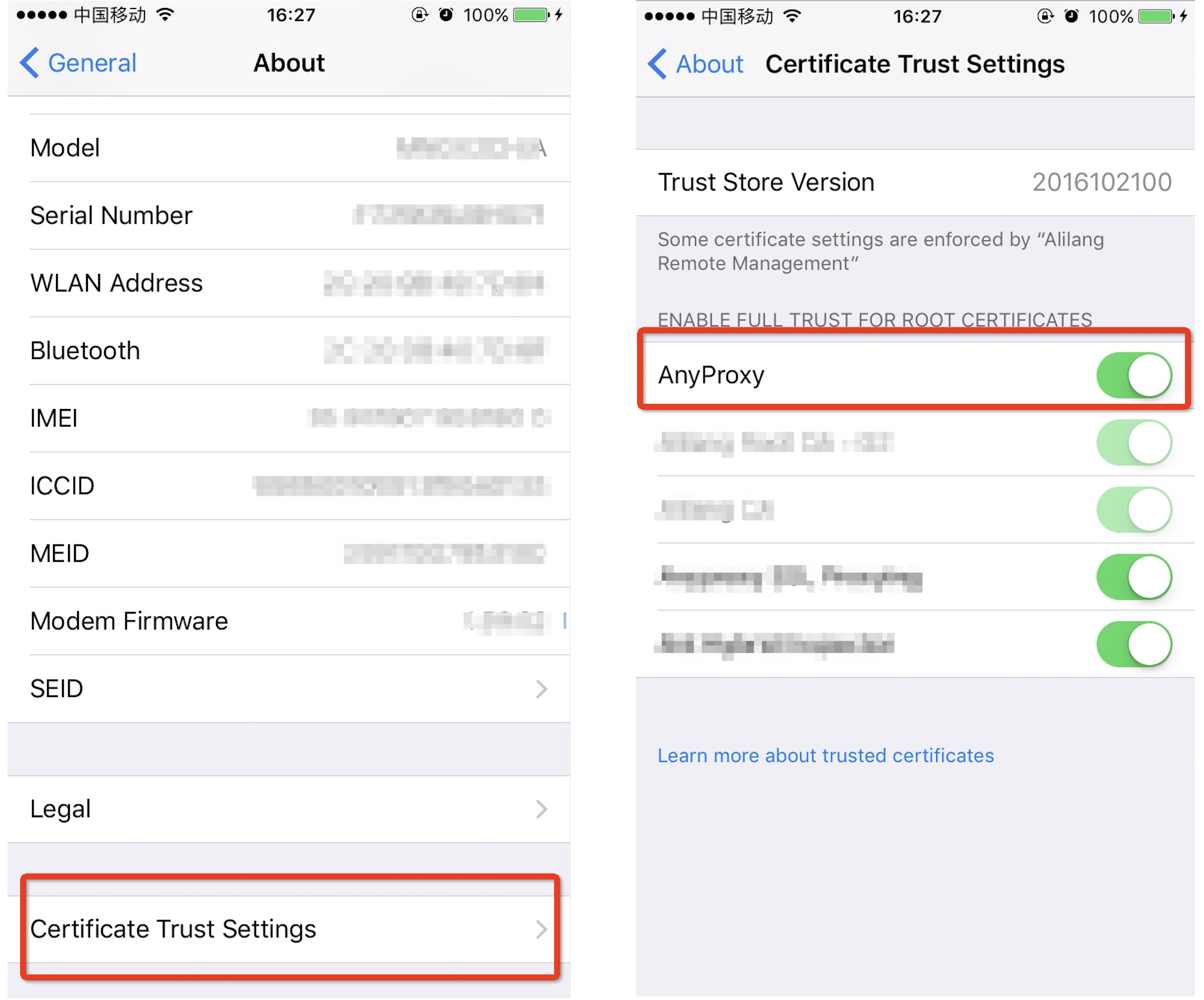
安卓系统信任CA证书
首先和iOS类似,需要先扫描证书的二维码进行下载。然后不同的安卓系统安装证书的方式可能有所不同,但是安装的步骤是类似的,我们列举了几种类型。
- 下载后的证书可以直接单击打开并安装,这种方式是最简单的,直接安装即可
- 证书下载到指定目录后,需要从其他入口进行安装,包括:
- 设置 -> 安全性与位置信息 -> 加密与凭据 -> 从存储设备安装。找到你下载的证书文件,进行安装
- 设置 -> 安全 -> 从SD卡安装证书。找到你下载的证书文件,进行安装
不同安卓系统支持安装的证书文件类型不尽相同,大多支持安装拓展名为 .crt 的证书文件,少部分仅支持 .cer 文件(已知如 OPPO R15),AnyProxy 提供了多种类型的证书文件,可在下载安装时选择。
配置iOS/Android系统代理
代理服务器都在wifi设置中配置
iOS HTTP代理配置
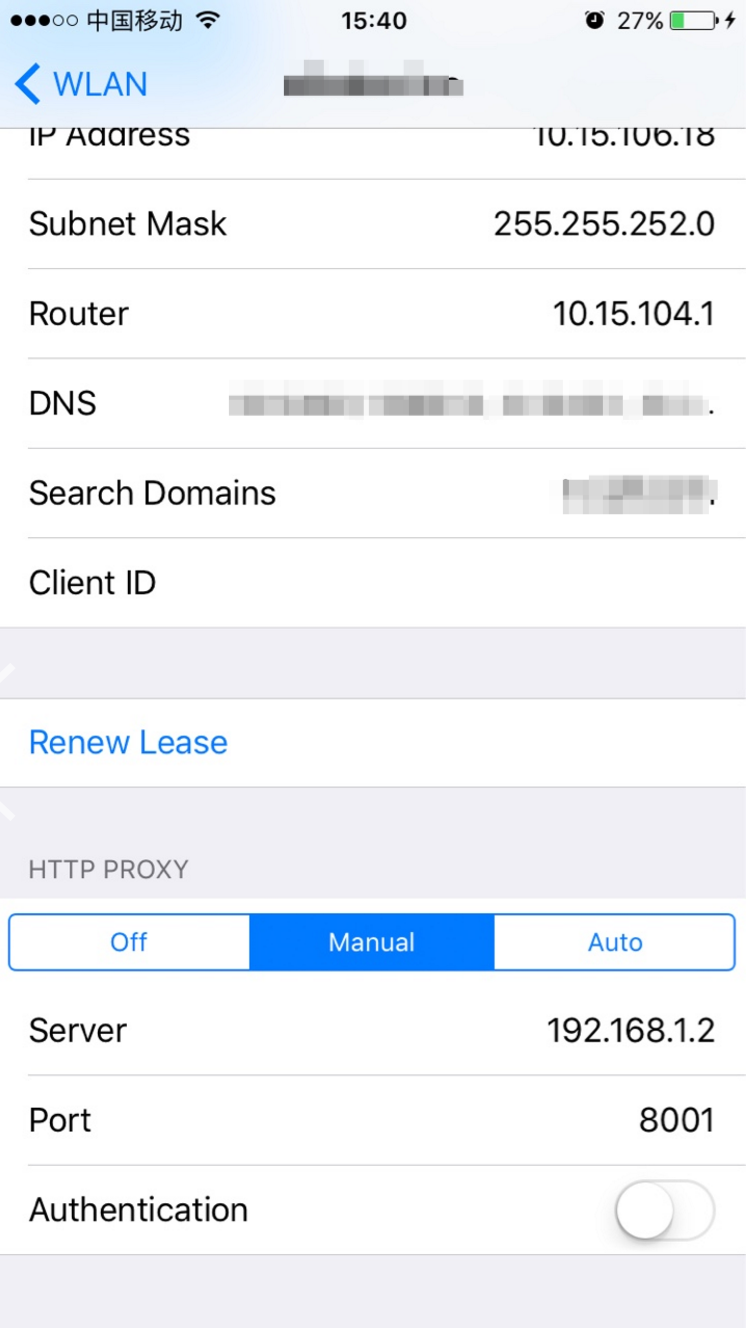
- Android HTTP代理配置
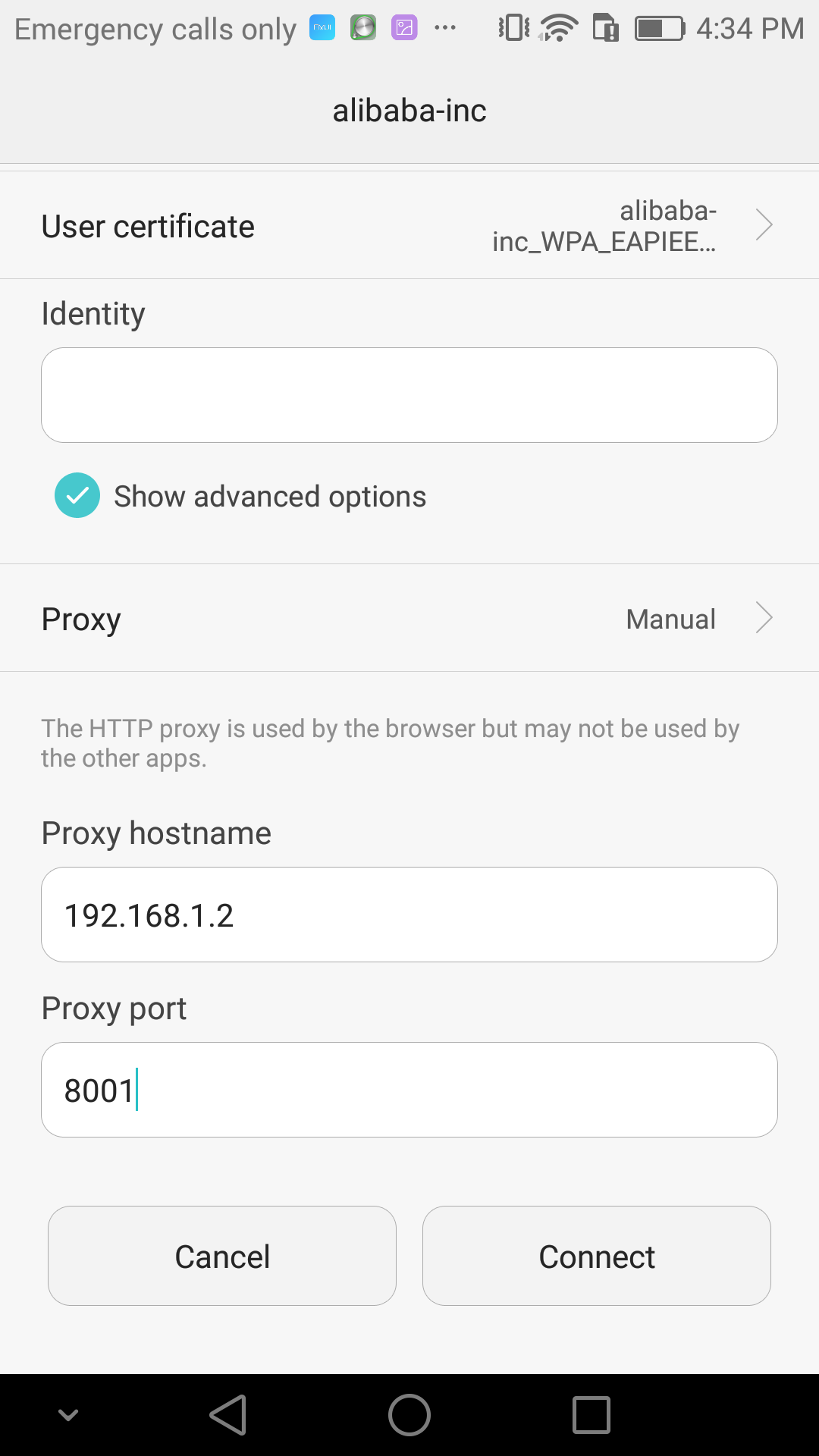
FAQ
Q: 为什么https请求不能进入处理函数?
A: 以下任意一项都能用来改变https的处理特性:
1. 命令行启动AnyProxy时配置`--intercept`参数,按npm模块启动时配置`forceProxyHttps`参数,所有Https请求都会被替换证书并解析
2. 规则文件内提供`beforeDealHttpsRequest`方法,返回 *true* 的https请求会被解析
Q: 提示 function is not yieldable
- A: 规则模块是用 co 驱动的,函数需要满足yieldable。可以使用generator方法或是返回Promise。
Q: The connection is not private
当访问特定的HTTPS站点,AnyProxy会提示该站点不是一个安全的网站,这通常是因为站点的证书设置不能被正确识别导致的(比如,站点的证书是自签发的)。如果您信任该网站,可以用以下方式来继续访问:
命令行直接启动
通过启动参数
--ignore-unauthorized-ssl来忽略证书认证的错误。需要注意的是,该参数是全局生效的,如果你在此期间访问了其他未知的网站,他们的证书问题也会被忽略,这可能会带来安全隐患。anyproxy -i --ignore-unauthorized-ssl在Nodejs代码中启动
在构造AnyProxy实例的时候,传入参数
dangerouslyIgnoreUnauthorized:true, 如下:const options = { ..., dangerouslyIgnoreUnauthorized: true }; const anyproxyIns = new AnyProxy.ProxyCore(options); anyproxyIns.start();通过这种方式初始化的AnyProxy,其配置也是全局性的,所有网站的证书问题都会被忽略
通过自定义的Rule来修改
我们自然也可以借助自定义的Rule来实现这个效果,而且我们还可以控制到只允许指定网址的证书错误,对不在列表的网址,进行证书的强验证。
module.exports = { *beforeSendRequest(requestDetail) { if (requestDetail.url.indexOf('https://the-site-you-know.com') === 0) { const newRequestOptions = requestDetail.requestOptions; // 设置属性 rejectUnauthorized 为 false newRequestOptions.rejectUnauthorized = false; return { requestOptions: newRequestOptions }; } }, };